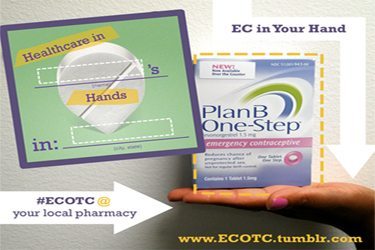Health Care in Our Hands: Celebrating a Decade of Work to Get Emergency Contraception on Store Shelves
August 1 is the one-year anniversary of the Affordable Care Act regulation requiring no cost-coverage of women’s preventive services—including contraception—going into effect. Now we can also celebrate the fact that Plan B One-Step is finally on store shelves across the country.

August 1 has become an important day for women’s health. Not only does it mark the one-year anniversary of the Affordable Care Act regulation requiring no-cost coverage of women’s preventive services—including contraception—going into effect, but now we can also celebrate the fact that Plan B One-Step emergency contraception is finally on store shelves across the country and more accessible than ever before.
Reproductive health, rights, and justice advocates work hard every single day to ensure that women and men are equipped with the tools and information they need to plan pregnancies and determine the course of their own lives. But we seldom take the time to celebrate our victories when they do occur—or to acknowledge and learn from the work that makes victories like August 1 possible.
In the case of emergency contraception (EC), advocates, activists, lawyers, lawmakers, researchers, and health-care providers have been working for more than a decade to make safe and effective back-up birth control available to all—without a prescription, age limits, or delays. Here are some of the highlights from that history:
-
1995 – Reproductive Health Technologies Project (RHTP) board members Felicia Stewart and Charlotte Ellertson champion an “idea” for a product that would prevent pregnancies after intercourse.
-
1997 – Sharon Camp, also an RHTP board member at the time, starts the Women’s Capital Corporation, responsible for the development and commercialization of Plan B emergency contraception.
-
1999 – James Trussell and Marie Bass launch a hotline and a groundbreaking television and radio campaign to educate the public about EC.
-
2001 – RHTP, the Center for Reproductive Rights (CRR), and groups including the American Academy of Pediatrics and the Association of Reproductive Health Professionals, submit a Citizen’s Petition to the Food and Drug Administration (FDA).
-
2003 – Two FDA advisory committees overwhelmingly recommend the sale of Plan B over the counter (OTC) without a prescription.
-
2004 – Despite its experts’ own recommendations, the FDA denies approval of Plan B OTC.
-
2005 – CRR files a lawsuit, using the Citizen’s Petition and leaked FDA staff review memos.
-
2005 – After months of internal and external wrangling, Dr. Susan Wood resigns from the FDA in protest of the Bush administration’s disregard for scientific and clinical evidence.
-
2005 – National Women’s Liberation protests the FDA’s delay in New York City—a tradition that continues into 2013.
-
2006 – Thanks to the efforts of Sens. Hillary Rodham Clinton and Patty Murray, the Bush administration is forced to concede OTC access for those 18 and older in order to get the next FDA commissioner confirmed.
-
2009 – Judge Edward Korman finds that politics had trumped science, orders the age restriction on OTC access to be lowered to 17, and demands that the FDA revisit its decision on EC.
-
2009 – The National Latina Institute for Reproductive Health publishes a primer on birth control and emergency contraception aimed at Latina women, available in English and Spanish.
-
2009 – Elizabeth Raymond and colleagues publish research demonstrating that people ages 12 to 17 can use EC safely without assistance from a gatekeeper like a physician or pharmacist.
-
2011 – In an unprecedented move, Department of Health and Human Services Secretary Kathleen Sebelius overrules the FDA’s decision to grant OTC access to Plan B One-Step, and CRR reopens its lawsuit against the FDA.
-
2012 – Tina Raine and colleagues publish findings showing that young people can use EC safely in an over-the-counter context.
-
2012 – The American College of Obstetricians and Gynecologists releases a statement calling for the removal of unnecessary restrictions on EC.
-
2012 – RHTP and other women’s health advocates keep the pressure on with a nationwide social media campaign calling on the Obama Administration to remove restrictions on EC.
-
2013 – The American College of Clinical Pharmacy issues its support for the elimination of barriers to EC.
-
2013 – Finally, after Judge Korman kicks up the heat and rules that the FDA must make EC available without restrictions, and the Department of Justice loses an important part of its appeal, we cry “Victory!” as the headlines read, “Feds Cave on EC Age Restrictions.”
Now, because of those efforts and the efforts of so many others, anyone will be able to walk into a pharmacy or grocery store and grab EC from the store shelf. They won’t have to wait or come back when the pharmacy counter is open. They won’t have to be embarrassed to ask for it in front of others or be shamed about needing to use it. They won’t have to show identification or find someone who has identification to buy it for them. Finally, our health care is in our hands.
But while we can claim “victory,” we cannot claim “mission accomplished.” The FDA granted Teva Pharmaceuticals, the maker of Plan B One-Step, three-year market exclusivity for an over-the-counter EC product for all ages—which means that until April 2016, all generic versions of EC will continue to have cumbersome and unnecessary age restrictions. Additionally, the average price of generic EC is $41, only $7 less than the average cost of $48 for Plan B One-Step. Clearly, there is a lot more work to do.
Even so, on Thursday we celebrate. And we honor the hard work, the vision, the creativity, and the perseverance of those who put EC in women’s hands. To them we say, thank you.
To help us celebrate, please share photos and videos of EC in your hands. Learn more at http://ecotc.tumblr.com.


